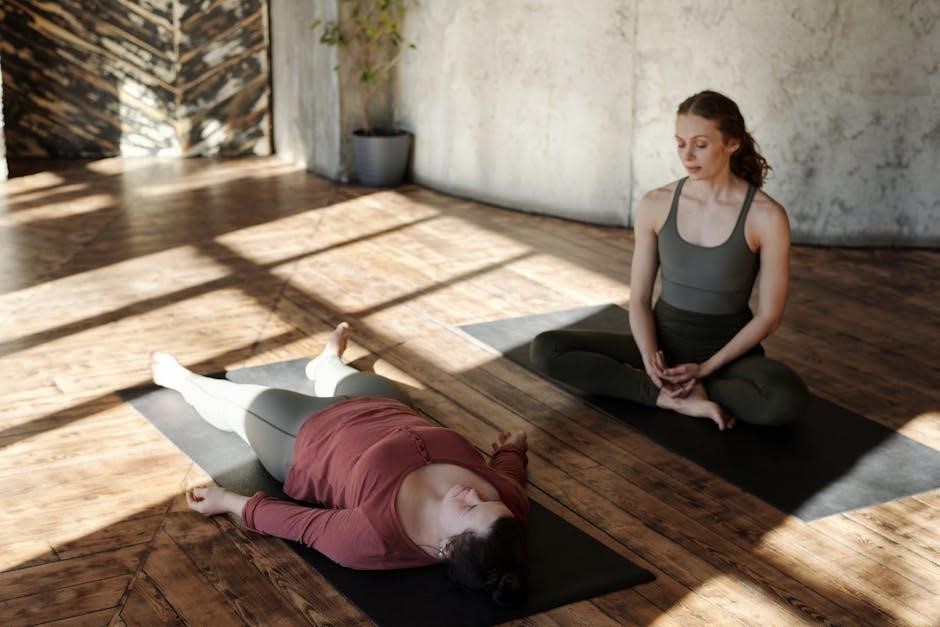Bausch + Lomb ULTRA for Presbyopia contact lenses address the challenges of presbyopia, a common age-related vision condition․ These lenses offer a seamless viewing experience, allowing wearers to shift focus naturally from near to far․
Overview of Presbyopia and Contact Lens Correction
Presbyopia typically emerges after age 40, impairing the ability to focus on close-up tasks․ Contact lenses offer a versatile solution for presbyopic individuals․ Bausch + Lomb ULTRA for Presbyopia lenses provide comfortable and effective vision correction․ These multifocal lenses enable a smooth transition between distance and near vision․ They aim to provide clear eyesight at all distances, reducing the need for reading glasses․ A fitting guide ensures practitioners can achieve optimal vision outcomes for their patients, enhancing their daily life with improved focus․ Proper fitting is key․
The Bausch + Lomb ULTRA Lens Family
The Bausch + Lomb ULTRA lens family includes options for various vision correction needs․ Besides the ULTRA for Presbyopia, the family features lenses for myopia and hyperopia․ The ULTRA Multifocal for Astigmatism combines presbyopia and astigmatism correction․ These lenses share the advanced MoistureSeal technology for enhanced comfort․ The ULTRA ONE DAY Multifocal is a daily disposable option for presbyopia․ The wide range of parameters within the ULTRA family allows for same-day, in-office fitting․ Practitioners can confidently address diverse patient needs with the Bausch + Lomb ULTRA lens options, providing tailored vision solutions․

Understanding the Design and Features
The Bausch + Lomb ULTRA for Presbyopia lenses feature a 3-Zone Progressive Design, ensuring smooth transitions between distance, intermediate, and near vision․ The Samfilcon A material and MoistureSeal technology provide exceptional comfort and hydration․
3-Zone Progressive Design
The 3-Zone Progressive Design is a key feature of Bausch + Lomb ULTRA for Presbyopia lenses․ This innovative design allows for a natural shift in focus across various distances․ The lens incorporates distinct zones to optimize vision for near, intermediate, and distance tasks․ This design philosophy aims to provide a smooth visual experience, mimicking natural vision as closely as possible․ The zones work together to accommodate the varying visual demands of presbyopic patients, minimizing the need for excessive head movements or eye strain․ This allows wearers to seamlessly transition between activities․
Samfilcon A Material and Moisture Technology
Bausch + Lomb ULTRA lenses are crafted from Samfilcon A, a silicone hydrogel material known for its high oxygen transmissibility․ This material promotes corneal health and comfort during extended wear․ Paired with MoistureSeal technology, these lenses maintain exceptional moisture retention, reducing dryness and enhancing overall comfort․ The MoistureSeal technology allows the lenses to retain a high percentage of their moisture, even after hours of wear․ This combination of material and technology is engineered to provide a comfortable and hydrating lens-wearing experience for individuals with presbyopia․
Parameter Range and Availability
Bausch + Lomb ULTRA for Presbyopia contact lenses offer a wide range of parameters to accommodate diverse patient needs․ This includes a variety of sphere powers, cylinder powers, axes, and add powers․ The extensive parameter range ensures that eye care professionals can find an optimal fit for a vast majority of patients, including those with astigmatism․ These lenses are widely available through eye care practitioners․ The availability of fitting sets and the option to order custom parameters provide flexibility in the fitting process, contributing to improved first-fit success rates and patient satisfaction․

Initial Fitting Steps
The initial fitting of Bausch + Lomb ULTRA for Presbyopia lenses involves updating the spectacle refraction and determining the appropriate add power․ Vertex distance should be adjusted, followed by selecting the initial lens power․
Spectacle Refraction and Add Power Determination
The first critical step in fitting Bausch + Lomb ULTRA for Presbyopia lenses involves obtaining an accurate, up-to-date spectacle refraction․ This measurement forms the foundation for selecting the appropriate contact lens power․ Equally important is determining the patient’s add power, which corrects for near vision deficits caused by presbyopia․ Careful consideration of both distance and near prescriptions is essential to achieve optimal visual outcomes with these multifocal contact lenses․ The add power will dictate the near vision correction provided by the lens․
Vertex Distance Adjustment
Following spectacle refraction and add power determination, a crucial adjustment accounts for vertex distance․ This measurement represents the space between the back surface of the spectacle lens and the front surface of the cornea․ When the spectacle prescription exceeds ±4․00D, vertex distance becomes significant․ Convert the spectacle power to the equivalent contact lens power using a vertex distance table or calculator․ This conversion ensures accurate power delivery when switching from spectacles to Bausch + Lomb ULTRA for Presbyopia contact lenses, optimizing visual acuity and comfort for the patient․
Selecting Initial Lens Power Based on Fitting Guide
After determining the vertex-corrected spectacle power, the next step involves consulting the Bausch + Lomb ULTRA for Presbyopia fitting guide․ This guide provides recommendations for selecting the initial lens power based on the patient’s spherical equivalent and add power․ The fitting guide simplifies the process, ensuring a predictable fit․ Select the contact lens distance prescription based upon the spherical equivalent from the spectacle Rx and the corresponding add power․ This initial selection is crucial for achieving optimal visual acuity and comfort with the multifocal lenses․

In-Office Fitting and Evaluation
The in-office fitting process involves assessing lens centration and movement on the eye․ Visual acuity is evaluated at both distance and near․ Hand-held lenses are used to refine the fit and optimize vision․
Assessing Lens Centration and Movement
Evaluating lens centration and movement is crucial for successful multifocal contact lens fitting․ Proper centration ensures that the different zones of the lens align correctly with the pupil for optimal vision at various distances․ Observe the lens position relative to the cornea and iris․ Look for any decentration, which can lead to blurred vision or discomfort․ Assess lens movement by having the patient blink․ Excessive or insufficient movement can impact vision and comfort․ Aim for a stable, well-centered lens with adequate movement to allow for tear exchange and corneal health․
Evaluating Visual Acuity at Distance and Near
After the lenses have settled, assess the patient’s visual acuity at both distance and near․ Use a Snellen chart to evaluate distance vision and a near vision chart to assess near vision․ Ask the patient to read the smallest line they can see clearly on each chart․ Note the visual acuity achieved with each eye individually and with both eyes together (binocularly)․ If the patient’s vision is not satisfactory, consider refinements to the lens power or add power․ Accurate assessment of visual acuity is essential for determining the effectiveness of the multifocal lens correction․

Using Hand-Held Lenses for Refinement
To fine-tune visual acuity, employ hand-held lenses over the fitted Bausch + Lomb ULTRA for Presbyopia lenses․ Begin by assessing binocular vision in normal room illumination․ If distance vision needs improvement, add -0․25D lenses to the dominant eye․ For near vision enhancements, add +0․25D lenses, particularly to the non-dominant eye, especially when using a High Add lens․ Evaluate the patient’s subjective response to each adjustment․ Small changes can significantly impact overall visual satisfaction․ This method allows for precise customization, ensuring optimal vision correction for individual patient needs․

Troubleshooting and Refinement
Fine-tuning the lens power ensures optimal vision․ Adjustments may be needed for distance or near vision․ Consider Bausch + Lomb ULTRA Multifocal for Astigmatism to address astigmatism, utilizing cylinder powers for precise correction․
Adjusting Power for Distance Vision Improvement
To enhance distance visual acuity, consider adjustments to the dominant eye․ If the patient reports difficulty seeing objects at a distance, refine the lens power by adding -0․25D increments․ Evaluate binocular vision in normal room illumination after each adjustment․ This method aids in determining the optimal lens power for clear distance vision․ Accurate refinement ensures the patient achieves satisfactory visual acuity and reduces visual strain during daily activities requiring clear distance sight, such as driving or watching television․ This systematic approach optimizes the lens for individual visual needs․

Adjusting Power for Near Vision Improvement
For those experiencing difficulty with near vision while wearing Bausch + Lomb ULTRA for Presbyopia lenses, adjustments can be made to enhance close-up visual acuity․ Increase the power in 0․25D steps, adding to the non-dominant eye, especially when using a High Add lens․ It is important to evaluate the patient’s binocular vision after each adjustment to ensure balanced vision․ This process fine-tunes the lens power, optimizing near visual tasks like reading․ Adjustments must be small to prevent vision imbalance․ Continue until satisfactory near visual acuity is achieved․
Addressing Astigmatism with ULTRA Multifocal for Astigmatism
For patients with presbyopia and astigmatism, Bausch + Lomb offers the ULTRA Multifocal for Astigmatism․ This lens combines the 3-Zone Progressive Design with toric correction․ This lens includes cylinder powers up to -2․25D․ A -2․75D cyl power can also be ordered from BL․ This lens is the only lens that comes with a fitting set for immediate in-office fitting․ This design ensures stable vision, correcting both refractive errors․ Proper alignment and power selection are essential for optimal outcomes․ The fitting process should follow the manufacturer’s guidelines․ Evaluate lens rotation and stability to ensure accurate astigmatic correction․

Patient Education and Expectations
Patient education is crucial for success with multifocal lenses․ Explain the adaptation process, proper lens care, and realistic expectations regarding vision․ Clear communication improves patient satisfaction and long-term compliance with lens wear․
Explaining the Adaptation Process
Adapting to multifocal contact lenses like Bausch + Lomb ULTRA for Presbyopia requires patience․ Explain to patients that their vision may fluctuate initially as their eyes adjust to the new lens design․ Emphasize that this adjustment period is normal and can take several days or even weeks․ Encourage them to wear the lenses consistently during this time to facilitate adaptation․ Reassure them that any initial blurriness or visual distortions should gradually diminish as their brain learns to interpret the new visual input․ Regular communication and support during this phase are essential for a successful outcome․
Proper Lens Care and Handling
Educate patients thoroughly on the importance of proper lens care and handling for Bausch + Lomb ULTRA for Presbyopia lenses․ Instruct them to always wash and dry their hands before handling the lenses․ Demonstrate the correct method for cleaning, rinsing, and disinfecting the lenses using recommended solutions․ Emphasize the need to avoid tap water, as it can harbor harmful microorganisms․ Advise patients to replace their lens case regularly and to never wear damaged or expired lenses․ Reinforce the importance of following the prescribed wearing schedule to maintain eye health and comfort․
Realistic Expectations for Multifocal Vision
Setting realistic expectations is crucial for patient satisfaction with Bausch + Lomb ULTRA for Presbyopia lenses․ Explain that while these lenses provide excellent vision at various distances, some adaptation may be required․ Patients may experience mild blurriness or halos, especially during the initial wearing period․ Emphasize that multifocal vision is a compromise, and perfect vision at all distances may not be achievable․ Reassure patients that with proper fitting and adaptation, they can enjoy comfortable and functional vision for most daily activities․ Manage expectations by highlighting the benefits of spectacle independence․

Success Rates and Patient Satisfaction
Bausch + Lomb ULTRA for Presbyopia boasts high first-fit success rates․ Patients report satisfaction with the lens’s ability to provide a natural shift in focus between near and far distances throughout their daily activities․
First-Fit Success Rates
Bausch + Lomb ULTRA for Presbyopia contact lenses demonstrate impressive first-fit success, especially when eye care professionals adhere to the recommended fitting guide․ Following the guide, which considers the lens’s 3-Zone Progressive Design, leads to efficient and accurate fittings․ Studies have shown that a significant percentage of patients, upwards of 80%, achieve a successful fit during their initial visit, highlighting the lens’s user-friendly design and predictable fitting process․ This translates to reduced chair time and enhanced patient satisfaction․
Patient Perception of Natural Vision Shift
Bausch + Lomb ULTRA for Presbyopia lenses are designed to provide a smooth transition between near, intermediate, and distance vision, mimicking natural sight․ A significant majority of patients, reportedly around 92%, agree that these lenses enable them to shift focus seamlessly throughout the day․ This natural vision shift contributes to a comfortable and adaptable wearing experience․ Patients often express satisfaction with the lenses’ ability to provide clear vision at various distances without the disruptive “swim” effect sometimes associated with multifocal lenses․

Additional Resources and Support
Practitioners can access a fitting calculator for ULTRA for Presbyopia, along with the package insert and fitting guide․ Technical support is also available to assist with fitting and troubleshooting for optimal patient outcomes․
Fitting Calculator Tools
Fitting calculator tools are invaluable for eye care professionals fitting Bausch + Lomb ULTRA for Presbyopia lenses․ These tools provide fitting instructions for ULTRA for Presbyopia, streamlining the lens selection process based on the patient’s refraction․ The calculator considers spectacle Rx, add power, and vertex distance to suggest an initial lens power․ These tools help estimate initial parameters, optimizing chair time and increasing first-fit success rates․ The fitting calculator ensures a more efficient and accurate fitting experience, leading to improved patient satisfaction with their multifocal contact lenses․
Package Insert and Fitting Guide Availability
The package insert and fitting guide for Bausch + Lomb ULTRA for Presbyopia lenses are essential resources for practitioners․ These documents provide comprehensive information on the lens characteristics, fitting procedures, and parameters․ The fitting guide offers step-by-step instructions, including how to update spectacle refraction, select initial lens power, and refine the fit․ It covers the 3-Zone Progressive Design and troubleshooting tips for optimal vision․ Access to the package insert and fitting guide ensures practitioners can confidently fit ULTRA for Presbyopia lenses, achieving first-fit success and patient satisfaction․
Technical Support for Practitioners
Bausch + Lomb offers robust technical support to assist eye care practitioners in fitting ULTRA for Presbyopia lenses․ This support includes access to fitting calculators, which provide guidance on lens selection based on spectacle refraction and add power․ Practitioners can also consult with technical specialists who can offer advice on troubleshooting challenging fits․ This support aims to optimize the fitting process and improve patient outcomes․ By leveraging these resources, practitioners can confidently manage presbyopic patients and provide them with comfortable and effective vision correction using Bausch + Lomb ULTRA lenses․